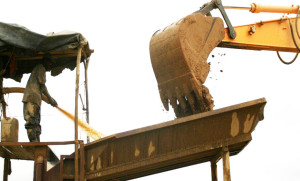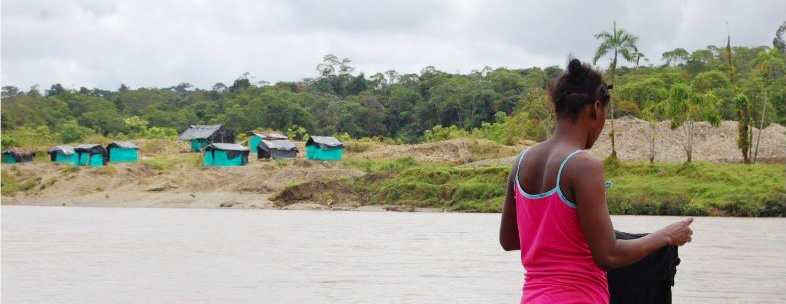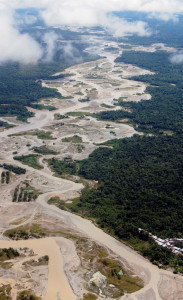by Louise Winstanley, Programme and Advocacy Manager, ABColombia
Chocó is situated between the Darién Gap on the border with Panama and the departments of Antioquia and Valle de Cauca. It is one of the planet’s hidden tropical treasures, classified as a Forest Reserve [i] and home to approximately 56 per cent of Colombian bird species and 11 per cent of all known bird species in the world [ii]. Chocó is also rich in mineral resources, particularly gold and platinum. It is therefore no coincidence that Chocó, a region rich in natural resources, has become one of the focal points of the Colombian conflict, with thousands of people killed or forcibly displaced.
Uncontrolled exploitation of small-scale mechanised gold mining in Chocó has proved to be a lucrative business for illegal armed groups. These groups operate in territories belonging to indigenous and Afro-descendant communities, spreading violence and fear, with opponents to mining threatened, attacked and killed. As well as generating violence, these mining operations have serious health and environmental impacts, threatening the lives and livelihoods of the population and damaging large areas of one of the world’s most biodiverse regions.
Chocó is an unusual department in that 96 per cent of the land in Chocó is collectively owned by indigenous or Afro-descendant peoples. For these ethnic groups, their territory embodies the essence of life and development. Therefore, Colombian law considers territory a fundamental right for these groups. Their livelihoods revolve around hunting, fishing, farming and small-scale artisanal mining. This way of life has preserved the rich biodiversity of this exceptional corner of Colombia, allowing it to meet the communities’ basic needs for centuries.
 However, in the 1980s a gold rush in the south of the department saw miners arrive with mechanical diggers and dredgers. Using mercury to separate out gold, they washed the residue into the rivers, along with other chemicals. Mercury pollution built up in the rivers of Chocó as a result of the rapid growth of small-scale mining operations. In 2009 a government commission revealed that four tons of mercury had been washed into Río Quito (above), just one of the tributaries of the Atrato River (the main river running through Choco) [iii]. In 2010 Colombia was named as the world’s worst per-capita mercury polluter from small-scale mechanised gold mining, and Chocó was one of the worst-affected areas in Colombia [iv]. Small-scale mechanised gold mining also became a lucrative business for illegal armed groups, increasingly important to them as a means of funding the conflict. Paramilitary and guerrilla groups not only extort ‘rents’ in exchange for ‘protection’, they also loan out machinery to these small-scale operations and sometimes even become owners of mining operations themselves.
However, in the 1980s a gold rush in the south of the department saw miners arrive with mechanical diggers and dredgers. Using mercury to separate out gold, they washed the residue into the rivers, along with other chemicals. Mercury pollution built up in the rivers of Chocó as a result of the rapid growth of small-scale mining operations. In 2009 a government commission revealed that four tons of mercury had been washed into Río Quito (above), just one of the tributaries of the Atrato River (the main river running through Choco) [iii]. In 2010 Colombia was named as the world’s worst per-capita mercury polluter from small-scale mechanised gold mining, and Chocó was one of the worst-affected areas in Colombia [iv]. Small-scale mechanised gold mining also became a lucrative business for illegal armed groups, increasingly important to them as a means of funding the conflict. Paramilitary and guerrilla groups not only extort ‘rents’ in exchange for ‘protection’, they also loan out machinery to these small-scale operations and sometimes even become owners of mining operations themselves.
As well as intensifying the conflict, small-scale mechanised mining has damaged the social fabric of many communities. First, the presence of these illegal armed actors severely limits the possibility of communities engaging in traditional artisanal mining, which only intensifies the threat to livelihoods already jeopardised by environmental damage to local rivers. This has forced some women to seek work as cooks and cleaners in mining camps, where they can face immense violence and poverty.
Community leaders in Chocó report a number of interrelated issues stemming from this form of mining:
‘…many women have been sexually affected by these guys who come here to mine, they offer them jobs and end up raping them and then other men [at the camp] continue raping them … there are women who are psychologically traumatised by what has happened to them… in order to work they have gone to these mining camps and because the mine owners are mixing together with the armed actors, the women are seen as collaborators and this affects them considerably because they are stigmatised as collaborating with armed groups… the lives of women are controlled by those who dominate their territory… they control their sexual life, the way in which they dress, everything… They start looking at them as women when they are only 10 years old’.
‘… [T]he chemicals used in mining affect the women’s bodies… you see women with skin blemishes on their bodies as a result of exposure to chemicals used in mining. Sometimes they have babies with deformities…’
‘The impacts of the mining activities have been disastrous for us; we are not the same communities as 10 years ago. We have experienced many crop failures; mercury causes disastrous problems in our community. In particular as farmers we experience the full impact… We do not use the waters from the river … the fish are no longer edible due to the mercury. People who eat the fish get stomach pain and diarrhoea’.
These communities also face a newer challenge as they discover that during their forced displacement much of their territory has been conceded to multinational companies (MNCs). Investment by MNCs in Chocó is actively promoted by the Colombian Government despite being associated with militarisation and social conflict. The majority of concessions granted to MNCs are in the early exploratory stage but they are already generating legal disputes and social protest. The communities have been working with lawyers and the Dioceses of Quibdó to mount legal challenges to mining operations, environmental destruction and human rights abuses.
While international norms and Colombian Constitutional Court judgements have strengthened the guarantees for Indigenous and Afro-descendant Peoples to “free, prior, and informed consent” processes, recent Colombian Government legislation appears to seek to circumvent these rights.
Communities are trying to find ways forward to address these issues, including through legal and environmental strategies. Some have been successful in preserving their territory and way of life, but the challenges they face remain significant. These challenges and their possible solutions will be explored at a conference hosted by ILAS at Senate House at the University of London on 11 November 2016. Places at this conference are limited so please reserve your place at: http://store.london.ac.uk/browse/extra_info.asp?compid=1&modid=5&deptid=179&catid=37&prodid=1072
For more information on our organisation visit: www.abcolombia.org.uk
Notes
[i] Ministerio de Ambiente, Vivienda y Desarrollo Territorial. Dirección de Licencias, Permisos y Trámites Ambientales. Oficio No 2400-E2-95921 de 02/09/2010. Suscrito por Magda Constanza Contreras Morales – Coordinadora Grupo de Relación con Usuarios.
[ii] Critical Ecosystem Partnership Fund, Ecosystem profile: Chocó-Manabí Conservation Corridor, Colombia and Ecuador, 2005.
[iii] Fiscalía General de Nación, Comunicado del 21 de abril de 2009, Bogotá cited by UPME (Unidad de Planeación Minera Energética) in Panorama del Sector Minero, August 2014.
[iv] NIDO, Antioquia, Colombia: the world’s most polluted place by mercury: impressions from two field trips, 2010.




Recent Comments